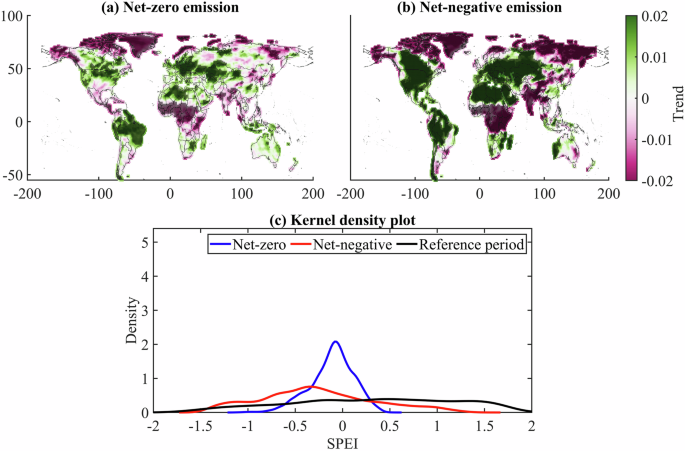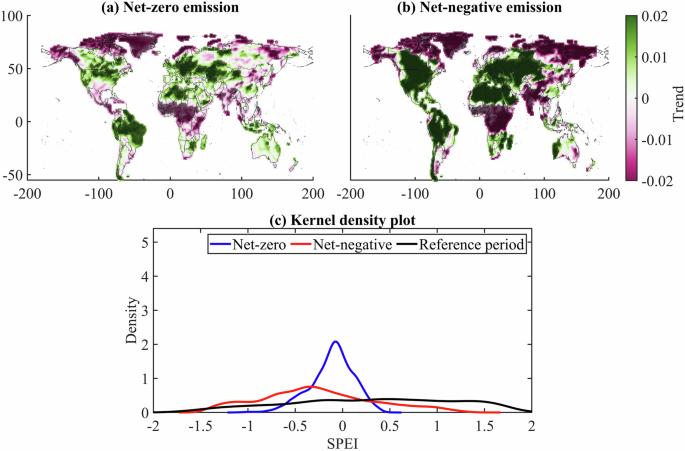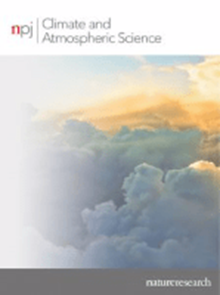Enhanced soil moisture–temperature coupling could exacerbate drought under net-negative emissions
IF 8.5
1区 地球科学
Q1 METEOROLOGY & ATMOSPHERIC SCIENCES
引用次数: 0
Abstract
Our understanding of drought evolution and land-atmosphere interactions under climate mitigation scenarios remains limited. Here, we analyzed future drought under net-zero and net-negative emission scenarios using the Community Earth System Model version 2, particularly focusing on three atmospheric CO2 states: linearly increases, decreases, and a return to the initial state. Interestingly, results revealed that net-zero emissions are more effective for drought mitigation than net-negative targets. Drying trends and drought characteristics — such as the duration, frequency, intensity, and area expansion are prominently increased under net-negative emissions due to higher potential evapotranspiration (PET). This is because the soil moisture and temperature couplings are stronger over drought regions and years, especially under net-negative forcing, with notable impacts in Central Africa and South Asia. Nevertheless, both target scenarios offer regional benefits, such as weakened dryness. This suggests that mitigating CO2 alone may not be sufficient to manage future droughts, highlighting the need for advanced water management strategies.


在净负排放条件下,土壤水分-温度耦合的增强会加剧干旱
我们对气候减缓情景下干旱演变和陆地-大气相互作用的了解仍然有限。在此,我们利用群落地球系统模式第 2 版分析了净零排放和净负排放情景下的未来干旱,尤其关注三种大气二氧化碳状态:线性增加、减少和回归初始状态。有趣的是,结果显示,净零排放比净负排放目标更能有效缓解干旱。由于潜在蒸散量(PET)增加,净负值排放条件下的干旱趋势和干旱特征(如持续时间、频率、强度和面积扩大)显著增加。这是因为在干旱地区和年份,土壤水分和温度的耦合作用更强,尤其是在净负效应下,对中非和南亚的影响更为显著。不过,两种目标情景都能带来区域效益,如干旱程度减弱。这表明,仅减缓二氧化碳的排放可能不足以管理未来的干旱,突出了对先进水资源管理战略的需求。
本文章由计算机程序翻译,如有差异,请以英文原文为准。
求助全文
约1分钟内获得全文
求助全文
来源期刊

npj Climate and Atmospheric Science
Earth and Planetary Sciences-Atmospheric Science
CiteScore
8.80
自引率
3.30%
发文量
87
审稿时长
21 weeks
期刊介绍:
npj Climate and Atmospheric Science is an open-access journal encompassing the relevant physical, chemical, and biological aspects of atmospheric and climate science. The journal places particular emphasis on regional studies that unveil new insights into specific localities, including examinations of local atmospheric composition, such as aerosols.
The range of topics covered by the journal includes climate dynamics, climate variability, weather and climate prediction, climate change, ocean dynamics, weather extremes, air pollution, atmospheric chemistry (including aerosols), the hydrological cycle, and atmosphere–ocean and atmosphere–land interactions. The journal welcomes studies employing a diverse array of methods, including numerical and statistical modeling, the development and application of in situ observational techniques, remote sensing, and the development or evaluation of new reanalyses.
 求助内容:
求助内容: 应助结果提醒方式:
应助结果提醒方式:


